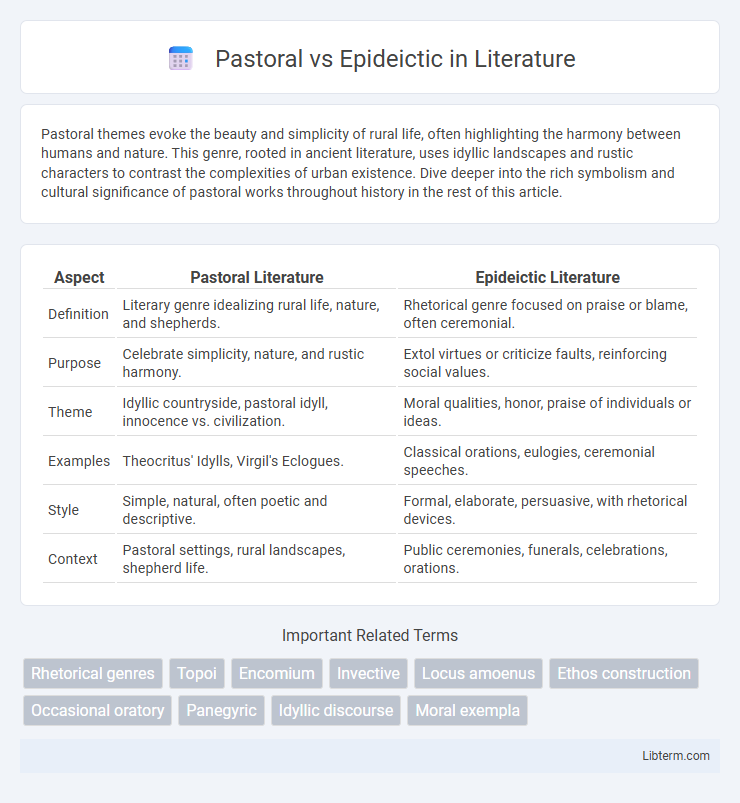Pastoral themes evoke the beauty and simplicity of rural life, often highlighting the harmony between humans and nature. This genre, rooted in ancient literature, uses idyllic landscapes and rustic characters to contrast the complexities of urban existence. Dive deeper into the rich symbolism and cultural significance of pastoral works throughout history in the rest of this article.
Table of Comparison
| Aspect | Pastoral Literature | Epideictic Literature |
|---|---|---|
| Definition | Literary genre idealizing rural life, nature, and shepherds. | Rhetorical genre focused on praise or blame, often ceremonial. |
| Purpose | Celebrate simplicity, nature, and rustic harmony. | Extol virtues or criticize faults, reinforcing social values. |
| Theme | Idyllic countryside, pastoral idyll, innocence vs. civilization. | Moral qualities, honor, praise of individuals or ideas. |
| Examples | Theocritus' Idylls, Virgil's Eclogues. | Classical orations, eulogies, ceremonial speeches. |
| Style | Simple, natural, often poetic and descriptive. | Formal, elaborate, persuasive, with rhetorical devices. |
| Context | Pastoral settings, rural landscapes, shepherd life. | Public ceremonies, funerals, celebrations, orations. |
Understanding Pastoral and Epideictic: A Brief Introduction
Pastoral and Epideictic rhetoric serve distinct functions within classical and modern communication frameworks. Pastoral rhetoric emphasizes idealized representations of rural life, nature, and simplicity, often evoking themes of tranquility and harmony in poetic or literary expressions. Epideictic rhetoric centers on praise or blame, commonly used in ceremonial contexts to reinforce societal values through speeches and commemorations.
Historical Origins of Pastoral and Epideictic Genres
Pastoral genre originated in ancient Greek literature, notably in Theocritus's Idylls, depicting idealized rural life and shepherds, serving as a contrast to urban complexity. Epideictic genre traces back to classical rhetoric, particularly Aristotle's Rhetoric, focused on speeches meant to praise or blame, designed for public display and ceremonial occasions. Both genres shaped subsequent literary traditions, with pastoral emphasizing simplicity and nature, while epideictic highlighted rhetorical skill in delivering encomiums or invectives.
Core Characteristics of Pastoral Rhetoric
Pastoral rhetoric centers on idealizing rural life, emphasizing harmony with nature, simplicity, and the moral virtues found in pastoral settings. It employs bucolic language and imagery to evoke tranquility and critique the complexities of urban existence or political corruption. The core characteristics include a focus on innocence, nostalgia, and the celebration of agrarian values as a counterpoint to societal deterioration.
Defining Features of Epideictic Rhetoric
Epideictic rhetoric centers on praise and blame, emphasizing values, virtues, and collective identity through celebratory or condemnatory speech. It employs vivid imagery, emotional appeals, and structured praise to reinforce communal norms and cultural ideals. Unlike pastoral rhetoric, which addresses practical guidance and moral instruction, epideictic rhetoric primarily aims to affirm social bonds and shared beliefs during ceremonies and commemorations.
Themes and Motifs: Nature vs. Praise
Pastoral literature often explores themes of nature, simplicity, and rural life, emphasizing motifs such as idyllic landscapes, shepherds, and natural harmony to evoke tranquility and nostalgia. Epideictic rhetoric centers on praise and blame, utilizing motifs of virtue, honor, and excellence to celebrate individuals, events, or ideas. While pastoral themes highlight an idealized connection with the natural world, epideictic themes focus on moral and social values through eloquent commendation or censure.
Purposes and Functions in Literature and Speech
Pastoral literature presents idealized rural life to evoke nostalgia and celebrate nature's simplicity, often aiming to critique urban society or highlight moral virtues. Epideictic speech functions to praise or blame, reinforcing community values and enhancing social cohesion through ceremonial or rhetorical occasions. Both forms emphasize cultural ideals but differ as pastoral seeks reflective escapism while epideictic promotes immediate ethical engagement.
Famous Examples of Pastoral Works
Pastoral literature often idealizes rural life, with famous examples including Christopher Marlowe's "The Passionate Shepherd to His Love" and Edmund Spenser's "The Shepheardes Calender," both of which celebrate the simplicity and beauty of nature. Another renowned pastoral work is Giovanni Boccaccio's "The Decameron," which frames its stories within a pastoral setting to explore themes of love and virtue. These works contrast sharply with epideictic rhetoric, which focuses on praise or blame, emphasizing moral lessons rather than the idyllic depictions found in pastoral literature.
Notable Instances of Epideictic Oratory
Epideictic oratory, characterized by praise or blame, is famously exemplified by Cicero's funeral speech "Pro Roscio Amerino," which skillfully combines encomium and invective to sway public opinion. Another notable instance is Pericles' Funeral Oration, delivering encomium to fallen Athenian soldiers while reinforcing civic values and democratic ideals. Such speeches showcase the power of epideictic rhetoric in shaping communal identity and moral attitudes during public ceremonies.
Pastoral and Epideictic in Modern Contexts
Pastoral rhetoric in modern contexts centers on guiding communities through empathy, moral reflection, and spiritual care, often employed by religious leaders and counselors addressing contemporary social challenges. Epideictic rhetoric today emphasizes praise or blame in contexts such as political speeches, award ceremonies, and social media, reinforcing community values and identities through symbolic language. Both forms serve distinct functions: pastoral discourse nurtures ethical development and emotional support, while epideictic rhetoric strengthens group cohesion by celebrating shared ideals.
Comparing Pastoral and Epideictic: Key Differences and Overlaps
Pastoral rhetoric centers on guiding behavior and offering practical advice within a moral or ethical framework, often employing a nurturing tone to influence future actions. Epideictic rhetoric, by contrast, primarily focuses on praise or blame to affirm communal values and reinforce social bonds during ceremonial occasions. While pastoral appeals to reform and instruction, epideictic emphasizes celebration and validation, intersecting in their use of emotional engagement and value-oriented discourse.
Pastoral Infographic

 libterm.com
libterm.com